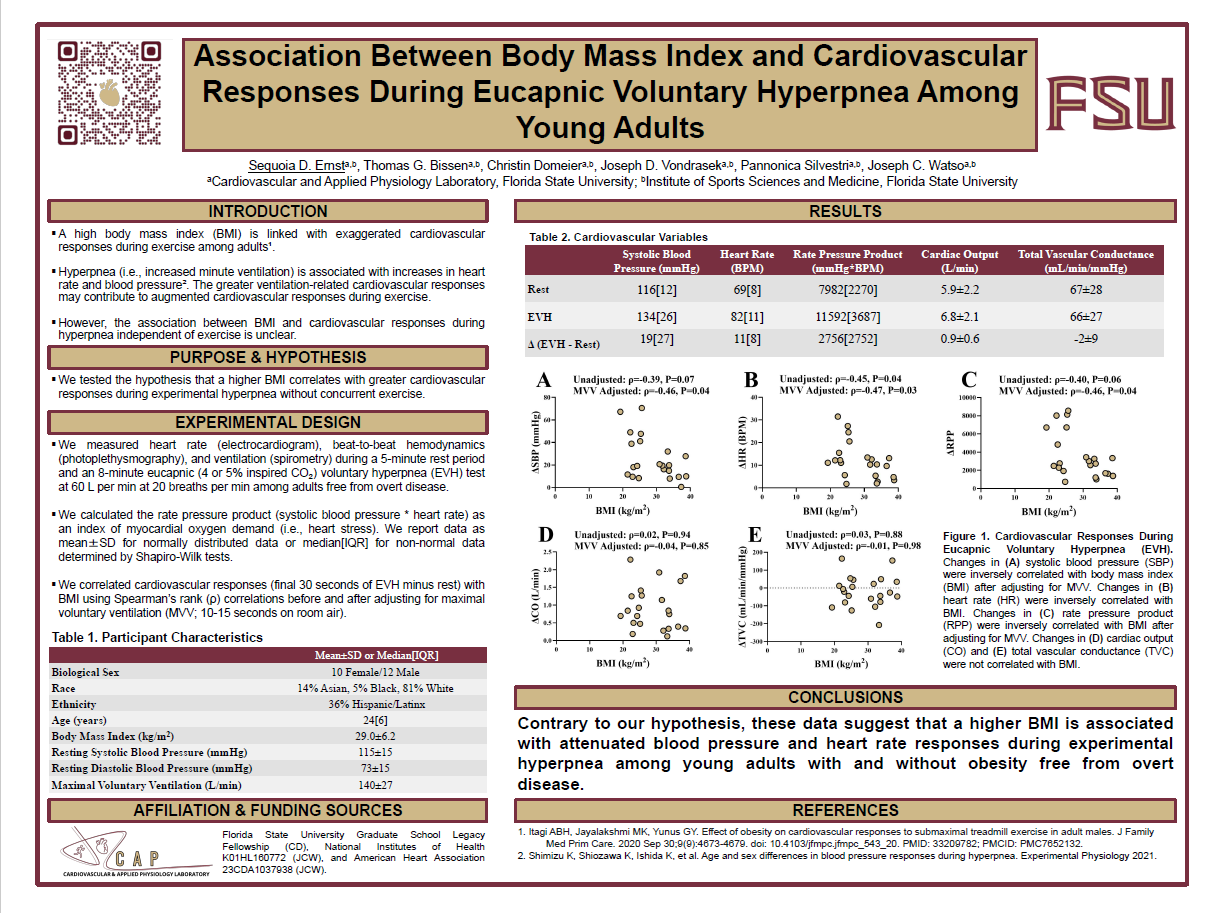Research Symposium
25th annual Undergraduate Research Symposium, April 1, 2025
Sequoia Ernst Poster Session 1: 9:30 am - 10:30 am/ Poster #235

BIO
Hi, I’m Sequoia Ernst. I’m a senior majoring in Exercise Physiology. I got started in research through the UROP program and am now working in Dr. Watso's cardiovascular applied physiology lab assisting with work on inspiratory muscle training. Once I’m done at FSU I plan to pursue graduate school to continue doing research. Ultimately I hope to complete a PhD and work as a professor. I’m interested in the intersections of the cardiovascular, pulmonary and neurological systems, memory and learning, blood-flow restriction exercise training, metabolic syndrome, and plant-based nutrition research.
Association Between Body Mass Index and Cardiovascular Responses During Eucapnic Voluntary Hyperpnea Among Young Adults
Authors: Sequoia Ernst, Joseph WatsoStudent Major: Exercise Physiology
Mentor: Joseph Watso
Mentor's Department: Health, Nutrition, and Food Sciences Mentor's College: Education, Health and Human Sciences Co-Presenters:
Abstract
Introduction: High body mass index (BMI) is linked with exaggerated cardiovascular responses during exercise. However, the association between BMI and cardiovascular responses during hyperpnea independent of exercise is unclear. Purpose: We tested the hypothesis that higher BMI correlates with greater cardiovascular responses during eucapnic voluntary hyperpnea (EVH). Methods: Inclusion criteria were 20-45 years old, BMI <40 kg/m2, no cardiometabolic or pulmonary diseases, uncontrolled hypertension, or nicotine use. We measured beat-to-beat hemodynamics (photoplethysmography) and ventilation (spirometry) during a 5-minute rest period and 8-minute EVH test at 60 L/min ventilation. We correlated cardiovascular responses (Δ; EVH final 30 seconds minus rest) with BMI using Spearman’s rank (ρ) correlations before and after adjusting for maximal voluntary ventilation (MVV; 10-15 seconds on room air). We present data as mean±SD or median[IQR]. Results: The sample (n=22) characteristics were: 24[6] years old; 45% female; 14% Asian, 5% Black, 82% White; 36% Latinx. BMI (29.0±6.2 kg/m2) showed weak moderate correlations with Δmean arterial pressure (ΔMAP) (19±13 mmHg; ρ=-0.48, P=0.03) and Δheart rate (ΔHR) (12±8 beats/min; ρ=-0.45, P=0.04). However, BMI had negligible correlations with Δcardiac output (ΔCO) (0.9±0.5 L/min; ρ=0.02, P=0.94) and Δtotal vascular conductance (ΔTVC) (-2±9 mL/min/mmHg; ρ=0.03, P=0.88). Adjusting for MVV (140±27 L/min) did not meaningfully affect the correlations between BMI and ΔMAP (ρ=-0.50, P=0.02), ΔHR (ρ=-0.47, P=0.03), ΔCO (ρ=-0.04, P=0.85), or ΔTVC (ρ=-0.01, P=0.98). Conclusion: Contrary to our hypothesis, these data suggest a higher BMI is associated with a lower ΔMAP and ΔHR during EVH among adults with and without obesity free from overt disease.
Keywords: Cardiovascular Health Obesity Respiratory


